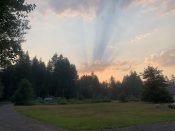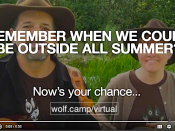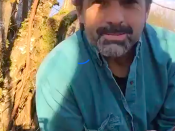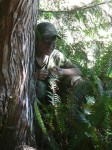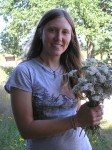Little Fire Starting Story
 From the time I set the woods on fire in second grade, to the many times I froze my bumba off during survival treks, trying to light matches or bow-drill fires in a downpour, fire has been one of my greatest teachers.
From the time I set the woods on fire in second grade, to the many times I froze my bumba off during survival treks, trying to light matches or bow-drill fires in a downpour, fire has been one of my greatest teachers.
What, you say? You set the woods on fire in second grade? Well yes, but it was Danny Donnell’s fault. I’m serious. No, really. C’mon! He was the big kid on the block, and he yelled at all of us to hurry down to the lake for swimming. I hung back, by myself, hurriedly piling plywood on the coals, hoping to smother them out. Little did I know – that’s exactly what coals want – to be covered up!
But the other boys were already gone, yelling at me from outside the woods, calling me a sissy for worrying about the fire. So I ran down to the lake with them to swim. Next thing I knew, my big brother Tom was laying rubber down the driveway in his ’65 Mustang, yelling out the window that the woods were on fire.
About 2,500 square feet burned before the fire department put it out, and we swore we weren’t at fault, despite the fact that our secret fort was obviously in the center of the burned area. Three days later, racked with guilt, I confessed to my mom, who simply said in her perfected Catholic voice, “but you swore to God.”
It was actually Andy Drewsonolich who swore to God. Really. Fine, don’t believe me. Maybe I agreed with Andy, but I didn’t actually say it. I can still feel the knot of guilt in my stomach that persisted for years afterwards. The Knot of Pergatory. Not as bad as the Fires of Hell, but hey.
Pillars of Fire
Making fire seems easy, especially when you do it for fun on a hot summer’s day. But when you really need it, fire can be the great humbler. In my order of survival article, you will see that the most important human needs are air, warmth, water and food.
Similarly, fire itself needs what I call the Pillars of Fire which create its foundation. The pillars are air, food and warmth itself. That’s right, take away enough air, take away its food, or drop the temperature low enough, and any fire will go out.
Food, aka fuel, is perhaps the most obvious thing people know that a fire needs. Everyone scrambles to find enough wood or various other material to throw at a fire, thinking that will help. Unfortunately, some food doesn’t really help. For instance, most leaves will do little more than smolder unless a fire is already raging. Yet some, like dried mugwort leaves, are excellent “coal extenders” that help coals live in the absence of flame.
Air is another thing most people know a fire needs. Unfortunately, we literally waste our breath blowing on flames, when instead, if there’s a small flame, blowing will put it out most of the time. A good rule of thumb is to only blow on coals, and then only if you didn’t build your “shelter” correctly.
Well-built shelter is what your fire really wants – to warm itself. The fuel (wood) itself, ironically, is usually what you make the shelter out of. Just cover your coals with a row of your best twigs, separated by a half inch. Cover those perpendicularly with a row of your next best wood. Repeat until you have created a well-ventilated structure I call the Chris-Cross Fire Oven. Sit back a few minutes and witness a miracle in about 10 minutes.
Or do what instructors Patrick & Charlie dub the WannaBlow which they advocate due to their youthful impatience. If you can’t wait 10 minutes, just wait about 5 and give your well-sheltered-and-ventilated coals a WannaBlow to see them burst into flame.
Starting Fires & Fire Safety
 Of course, everyone needs to learn fire’s infinite lessons on your own, because fire is an experiential thing, different every time. However, doing it right is more simple than we were often taught in the past. Just click on my Best Way To Make A Fire: Bed, Pillow & Blanket plus Criss-Cross Construction article for instruction on starting fire easily with all-natural materials.
Of course, everyone needs to learn fire’s infinite lessons on your own, because fire is an experiential thing, different every time. However, doing it right is more simple than we were often taught in the past. Just click on my Best Way To Make A Fire: Bed, Pillow & Blanket plus Criss-Cross Construction article for instruction on starting fire easily with all-natural materials.
If you “get” the take-home message of this article, you will also understand fire safety in a deep way. Dead giveaway: the foundation of the campfire is shelter, so if you want to put a fire out, remove all of its shelter. People accidentally start forest fires by covering their coals up, thinking the water they poured on it was enough.
Just like a kid in second grade.
Chris Chisholm founded Wolf Camp in 1996, and he is author of the Wolf Journey Earth Conservation Courses. He grew up in the north woods of Minnesota, spent his high school years in Germany and tromping around the Alps, studied in the Ecuadoran Andes for his college junior year abroad, and moved to the west coast after earning a B.A. from the University of Wisconsin in 1991.


